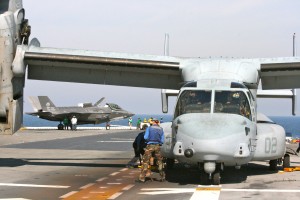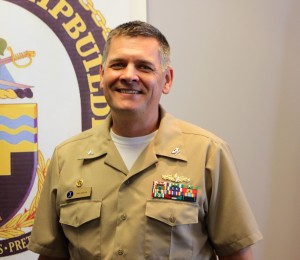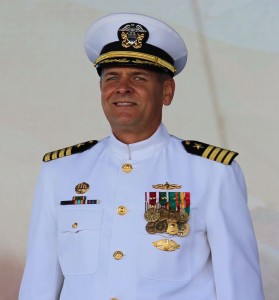2012-11-06 In a four-part follow up set of interviews, Second Line of Defense is looking at the role and impact of the USS America.
Interviews have been conducted with the prospective commander of the ship, the head of amphibious ship building in the USN, a senior USMC general on its role, and, finally, with the Deputy Commander, of the 2nd Expeditionary Strike Group, the role of the USS America as a flagship for an ESG is discussed.
Each interview has allowed us to focus on different aspects of the process of change associated with the ship.
- With Captain Hall we were able to focus on the integration of different capabilities aboard the ship.
- With Captain Mercer, the head of amphibious ship building in the USN, we were able focus on the intersection between those capabilities and innovation in the fleet.
- With Major General Walsh, Deputy Commanding General of the USMC Combat Development Command, we focused on how the ship provides an important impulse to the USMC approach to the future.
- And with Col. Bradley Weisz, Deputy Commander of 2nd Expeditionary Strike Group, we focused on the role of the USS America as a potential flagship for an ESG.
The day prior to the christening of the future USS America (LHA 6), Second Line of Defense sat down with Captain Chris Mercer, USN, Amphibious Ships Program Manager to discuss the ship and the approach to building the ship.
The ship is a new class of Large Deck Amphibious Ships built to work with current and new USN-USMC aircraft, and re-shape how LHAs operate in the 21st century. Captain Mercer also discussed the synergy between efforts on this ship with the new class of large deck carriers, the Ford class.

SLD: How would you characterize the design shift from the WASP to the AMERICA?
Mercer: It is more aviation centric. So the Flight 0 LHA (R), the America class ships are a modified repeat of the Wasp class ships.
If you look at the size of the ship, the size of the flight deck, they are very similar, as is the island.
You’ll see changes in the exhaust stack because of what we did down low in the ship for maintainability, sustainability and reduced total ownership cost.
But it is very much an aviation centric design. We essentially gave much more space to the aviation community, and included many of the cornerstone modifications required to support the joint strike fighter and MV22. We filled in the well deck volume that was used to bring the ground combat element to the beach via surface craft, with aviation support spaces: maintenance, fuel and weapons.
LHA(R) Rqmts Ltr–30 April 2004
SLD: What is the optimal loading of the F-35 Bravo?
Mercer: You could top end at 23 but it really depends on the footprint of all the logistics and support elements that’s coming with the aircraft.
SLD: With these new assets, the ship can play a role beyond simply being a lead in an ARG-MEU and provide a flagship role of an Expeditionary Strike Group.
Mercer: That is true. It can be part of shaping a sea shield. It can be married up with an LPD and LSD and brings in other strike capabilities and surface combatants.
And in the absence of a large deck carrier, you could do a load out of MV22s, and joint strike fighters providing the air dominance that you might need in a combined ARG type of amphibious assault.
We saw some of this presaged in Afghanistan 10 years ago, when the Marines projected deep ashore. The MV-22s with the F-35s will provide a powerful tandem to provide such support.

SLD: How are you working to shape synergy between the new aviation assets and the design of the ship?
Mercer: We have our partner design agents in Naval Air Systems Command (NAVAIR) who joined with us to design the ship specifically for that synergy of the MV22 and joint strike fighter through air ship integration work. That’s how we arrived at the design that we have for the Flight 0 ships America and Tripoli, which is LHA-7.
SLD: What about the C5ISR enablement of the ship?
Mercer: We have a very large C5ISR suite in the ship, one of the largest afloat.
The Navy, by Naval Sea Systems Command, SPAWAR, and also NAVAIR, designs our spaces and together we look at what those requirements are, the bandwidth and the types of circuits.
All of those are directed through our requirements process to determine what we put on the ship, and that results in what we call a total C5ISR integrated package or an acronym we call TCIP.
That equipment is all procured and put together in mock-ups down in Charleston, South Carolina.
We energize it all, test it all, and then we bring that integrated package to the ship.
In terms of the additional C5ISR type of information that will be coming from the joint strike fighter, that work is still ongoing.
But inside the ship, we’ve got plenty of margins to bring in those C5ISR systems into our command and control spaces, and electronic suite spaces. Certainly plenty of footprint for the various types of antennas they might need.
We are excited to get the ship out and exercise it, and show those capabilities to the Navy and the Marine Corp. I think they’ll be very pleased.
SLD: Even though you don’t have a well deck, the America is part of a fleet and will support insertion of vehicles at the appropriate moment as well. It is part of fleet and must shape your thinking?
Mercer: Those are the lines along which we think as well. When we think about vehicle lift, we look at the whole fleet. We look at what an ARG can bring. Our ship does have a vehicle square albeit we’ll lift that via airlift, and when you marry that up with an LPD and an LSD or even another ARG if you’re doing multiple ARGs, there will be significant vehicle lift. And prepositioned squadrons, and the joint high-speed vessel, will all contribute to vehicle lift as well.
SLD: When one thinks about LCS, or JHSV or whatever assets we are going to put into the littoral, the aviation assets operating off this ship are crucial for a reach back function for the littoral forces. How does this affect thinking about the America?
Mercer: If you can vector in from wherever that air support is for those sorts of littoral operations, and certainly a ship like the future USS America will be there with those aviation assets, in that same area of operation to provide support and cover.
SLD: Could you discuss the propulsion plant on the ship, which is an important enhancement in efficiency for the operation of the large deck amphibs.
Mercer: In the late 1990s, early 2000s we embarked on a design to remove all the steam, go all electric, and put a hybrid propulsion plant in LHD-8 where we would provide a propulsion gas turbine engine to do your sprints and to go fast to your objective.
But most of the life of the ship is spent under 12 knots.
We have carried this experience forward to the future USS America. We put in two 5,000-horsepower electric motors, and geared those into the same gear set that the main gas turbine engines are geared into, and that’s what we provide for propulsion.
In fact, most of the life of the ship, in design 75% of the life of the ship, will be on those electric motors. And we project most of its operational life underway will be with the auxiliary propulsion system.
The two-screw design inherent with this propulsion plant has advantages as well. If you wanted to do split plant operations and save fuel you can do that. If you want to go fast, you get both plants rolling full power ahead.

SLD: In shaping the configuration of the ship, obviously the workflow of the new aircraft will affect how the spaces are used on the ship. And you will do a lot of innovation as the ship starts to be used.
Mercer: We’re working with our NAVAIR and Marine Corp Aviation stakeholders to define what those spaces are that they need. First, to load out all of their support equipment in stores, in avionic support and maintenance spaces, and all of their workshops, but then also to sit down and look at how everything flows through the ship.
The workflow of everything from shops, and cargo magazines, and movement of yellow gear and aircraft through the hangar will be crucial to the operation of the ship.
We also expanded the hangar, made the hangar larger on the future America compared to the Wasp class, and gave it two maintenance high hats with aviation maintenance bridge cranes in there, so there is a significant expansion of the aviation maintenance capabilities in the ship which will enhance operations as well.
SLD: I assume that your efforts here are informing similar efforts for the folks building the new large deck carrier, the USS Ford?
Mercer: It is. It’s happening every day and with formal airship integrations, once a quarter to share all the things that we’re learning as we are moving both our programs mutually forward.
SLD: Finally, how do the F-35 and V-22 affect the ship design?
Mercer: The airplane’s bigger, the MV22 is larger than CH-46 by a fair amount; the F-35 is bigger than the Harrier.
Both have a bigger logistic footprint. The V-22 has unique maintenance requirements. We’ve got to open-up the airplane unfolded to be able to maintain it, something we didn’t have to do as much with the CH-46.
And the ship’s design has to take all of this into account.
For the first interview see the following:
https://sldinfo.com/captain-hall-discusses-the-uss-america-looking-towards-the-future/
Baseline Characteristics of USS America.
BLUF: LHA 6 (USS AMERICA) is basically an aviation-centric modified repeat of LHD 8 (USS MAKIN ISLAND); with no well deck.
Background Information:
– Key differences between LHA 6 and the LHD class ships include an enlarged hangar deck, enhanced aviation maintenance facilities, increased aviation fuel capacity, additional aviation storerooms, electronically reconfigurable C4ISR suite and removal of the well deck.
– Removal of the well deck for landing craft provides for an extended hangar deck with two significantly wider high bay areas, each fitted with an overhead crane for aircraft maintenance. These changes were required in order to operate the F-35B Joint Strike Fighter and MV-22B Osprey which are considerably larger than the aircraft they replace, the AV-8B Harrier & CH-46E.
– LHA 6 will provide a flexible, multi-mission platform with capabilities that cover the entire range of military operations (ROMO) from forward deployed crisis response to forcible entry operations.
– With a displacement of 45,000 tons, LHA 6 is as big as the aircraft carriers of other nations, and can easily fulfill similar missions when configured with 20 x F-35B Joint Strike Fighters.
– LHA 6 will also provide forward presence and power projection as an integral part of joint, interagency and multinational maritime expeditionary forces.
– Scheduled to be delivered to the U.S. Navy in late 2013, LHA 6 will eventually replace the USS PELELIU (LHA 5) which is currently operating with the Third Fleet Commander (C3F) on the West Coast.
– LHA 7, the USS TRIPOLI, is scheduled to be delivered to the U.S. Navy in late 2018.
– LHA 8 is currently being designed to be able to embark two LCACs or one LCU; a smaller well deck than that of the WASP Class LHDs.
General Characteristics of LHA 6 vs LHD 8
LHA 6 (USS AMERICA) LHD 8 (USS MAKIN ISLAND)
Length: 844 feet Length: 844 feet
Beam: 106 feet Beam: 106 feet
Displacement: 45,000 tons full load Displacement: 42,000 tons full load
Speed: 20+ knots Speed: 20+ knots
Crew: 65 officers, 1,059 enlisted Crew: 65 officers, 994 enlisted
Marines: 1,687 troops (184 surge) Marines: 1,687 troops (184 surge)
Aircraft: 12 x MV-22Bs, 6 x AV-8Bs, Aircraft: 12 x MV-22Bs, 6 x AV-8Bs,
4 x CH-53Es, 4 x AH-1s, 3 x UH-1s, 4 x CH-53Es, 4 x AH-1s, 3 x UH-1s,
2 x MH-60s 2 x MH-60s
Landing Craft: None Landing Craft: 3 LCACs or 2 LCUs
General Arrangement Considerations of LHA 6
– LHA 6 is an aviation-centric modified repeat of LHD 8
– LHA 6 hangar is significantly larger than LHD 1-8
– Aviation shops & storerooms generally larger than LHD 1-8
– LHA 6 cargo capacity greater than LHD 1-8
– LHA 6 JP-5 capacity greater than LHD 1-8
– LHA 6 vehicle capacity less than LHD 1-8
– LHA 6 has no well deck = no LCAC or LCU
Traditional MEU missions that LHA 6 could potentially support include:
– Conventional Operations (Amphibious Assaults, Raids & Demonstrations)
– Tactical Recovery of Aircraft & Personnel (TRAP)
– Humanitarian Assistance/Disaster Relief (HA/DR)
– Non-Combatant Evacuation Operations (NEO) & Embassy Reinforcements
– Aviation Ops from Expeditionary Shore-Based Sites/FOBs
– Theater Security Cooperation (TSC) Events
– Stability/Security Operations & Peace Enforcement
– Maritime Interdiction Operations (MIO)
– Reconnaissance & Surveillance (R&S)
– Airfield & Port Seizures
Summary
LHA 6, enabled with the F-35B JSF and MV-22B Osprey, significantly increases your ability to conduct over-the-horizon (OTH) ship-to-objective maneuver operations.
With the ability to project Marine Air-Ground Task Forces (MAGTFs) directly to critical operational objectives located deep inland while simultaneously dislocating our adversaries both in space and in time, LHA 6 becomes an immediate game changer.

